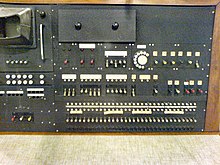Pilot ACE
 | |
| Developer | National Physical Laboratory (NPL) |
|---|---|
| Release date | 1950 |
| CPU | approximately 800 vacuum tubes @ 1 megahertz |
| Memory | 128 32-bit words; later expanded to 352 words (Mercury delay lines) |


The Pilot ACE (Automatic Computing Engine) was one of the first computers built in the United Kingdom[1] at the National Physical Laboratory (NPL) in the early 1950s. It was also one of the earliest stored-program computers, joining other UK designs like the Manchester Mark 1 and EDSAC of the same era. The design is one of the earliest general computers designed by Alan Turing, although he left NPL before it was completed.
History
Pilot ACE was a preliminary version of the full ACE, which had been designed by Alan Turing. After Turing left NPL (in part because he was disillusioned by the lack of progress on building the ACE), James H. Wilkinson took over the project. Donald Davies, Harry Huskey and Mike Woodger were involved with the design.[2][3] The Pilot ACE ran its first program on 10 May 1950,[4][5][6] and was demonstrated to the press in November 1950.[7][8]
Although originally intended as a prototype, it became clear that the machine was a potentially useful resource, especially given the lack of other computing devices at the time. After some upgrades to make operational use practical, it went into service in late 1951 and saw considerable operational service over the next several years. One reason the ACE was useful is that it was able to perform floating-point arithmetic necessary for scientific calculations. Wilkinson tells the story of how this came to be.[9]
The Pilot ACE was built without hardware for multiplication or division, in contrast to other computers at that time. The ACE started out using fixed-point multiplication and division implemented as software. It soon became apparent that fixed-point arithmetic was a bad idea because the numbers quickly went out of range. It only took a short time to write new software so that the ACE could do floating-point arithmetic. After that, James H. Wilkinson became an expert and wrote a book on rounding errors in floating-point calculations, which eventually sold well.[10]
Pilot ACE used approximately 800 vacuum tubes. Its main memory consisted of mercury delay lines with an original capacity of 128 32-bit words, which was later expanded to 352 words. A 4096-word drum memory was added in 1954. Its basic clock rate, 1 megahertz, was the fastest of the early British computers. The time to execute instructions was highly dependent on where they were in memory (due to the use of delay-line memory). An addition could take anywhere from 64 microseconds to 1024 microseconds.
The machine was so successful that a commercial version of it, named the DEUCE, was constructed and sold by the English Electric Company.
Pilot ACE was shut down in May 1955, and was given to the Science Museum, where it remains today.[11]
See also
References
- ^ Yates, David M. (1997). Turing's Legacy: A history of computing at the National Physical Laboratory 1945–1995. UK: Science Museum, London. pp. 126–146. ISBN 0-901805-94-7.
- ^ Yates, David M. (1997). Turing's Legacy: A history of computing at the National Physical Laboratory 1945–1995. UK: Science Museum, London. pp. 296, 300, 316. ISBN 0-901805-94-7.
- ^ Woodger, M. (1951). "Automatic Computing Engine of the National Physical Laboratory". Nature. 167: 270.
- ^ Campbell-Kelly, Martin (1981). "Programming the Pilot ACE: Early Programming Activity at the National Physical Laboratory". IEEE Annals of the History of Computing. 3 (1). IEEE: 133–162.
- ^ Atkinson, Paul (2010). Computer. Reaktion Books. p. 39. ISBN 9781861897374.
Pilot ACE 1950.
- ^ Kaisler, Stephen H. (2016). "Chapter Fourteen Pilot Ace". Birthing the Computer: From Relays to Vacuum Tubes. Cambridge Scholars Publishing. ISBN 9781443896313.
- ^ "Automatic Computing Machinery: News - National Physical Laboratory". Mathematics of Computation. 5 (35): 174–175. 1951. doi:10.1090/S0025-5718-51-99425-2. ISSN 0025-5718.
- ^ "9. The ACE Pilot Model, Teddington, England". Digital Computer Newsletter. 2 (4): 4. December 1950.
- ^ Rota, Gian-Carlo; et al., eds. (1980). History of Computing in the Twentieth Century. Academic Press.
- ^ Wilkinson, J. H. (1994). Rounding Errors in Algebraic Processes. reprinted by Dover.
- ^ "The Pilot ACE computer". UK: Science Museum (London). Archived from the original on 2016-08-19. Retrieved 2016-08-19.
Bibliography
- James H. Wilkinson, Turing's Work at the National Physical Laboratory and the Construction of Pilot ACE, DEUCE and ACE (in Nicholas Metropolis, J. Howlett, Gian-Carlo Rota, (editors), A History of Computing in the Twentieth Century, Academic Press, New York, 1980)
- Martin Campbell-Kelly, Programming the Pilot ACE (in IEEE Annals of the History of Computing, Vol. 3 (No. 2), 1981, pp. 133–162)
- B. Jack Copeland (editor), Alan Turing's Automatic Computing Engine. Oxford University Press, 2005 (ISBN 0-19-856593-3)
- Michael R. Williams, A History of Computing Technology. IEEE Computer Society Press, 1997. ISBN 0-8186-7739-2. Chap. 8.3.4.
- How Alan Turing's Pilot ACE changed computing, BBC News, 15 May 2010
Further reading
- Simon H. Lavington, Early British Computers: The Story of Vintage Computers and The People Who Built Them (Manchester University Press, 1980)
- David M. Yates, Turing's Legacy: A History of Computing at the National Physical Laboratory, 1945–1995 (Science Museum, London, 1997, ISBN 0-901805-94-7)
External links
- Oral history interview with Donald W. Davies, Charles Babbage Institute, University of Minnesota. Davies describes computer projects at the U.K. National Physical Laboratory, from the 1947 design work of Alan Turing to the development of the two ACE computers. Davies discusses a much larger, second ACE, and the decision to contract with English Electric Company to build the DEUCE—possibly the first commercially produced computer in Great Britain.
- The Pilot ACE in the Science Museum Group Collection
- How Alan Turing's Pilot ACE changed computing
- The world's first multi-tasking computer
